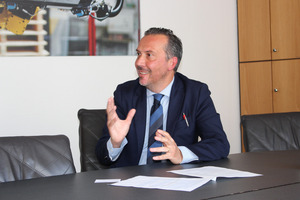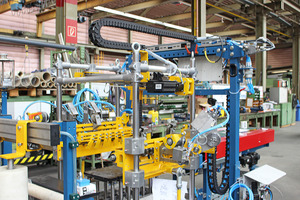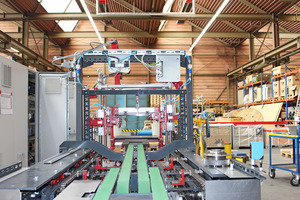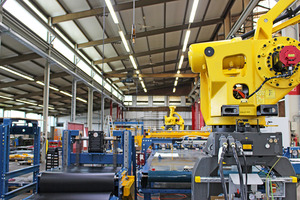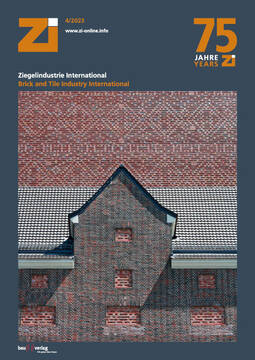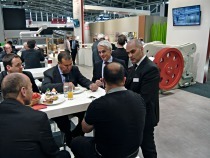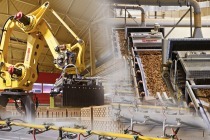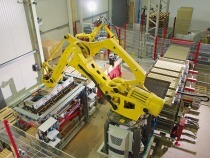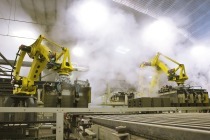Bricks will be a key part in future construction activities
Keller HCW is one of the supplier companies in the brick and tile industry with a long tradition. The company founder Carl Keller gave an impetus for the mechanization in the brick industry in 1894 with the development of the first finger car. The company, which has been part of Groupe Legris Industries since 2006, is active worldwide. Andrea Pasquali has been at the helm of Keller HCW for just over a year. He is no stranger to the industry and the ZI editorial team. We spoke to him last time in 2015, when he was still managing director of the Clay Preparation and Shaping Division (CPS) Rieter Morando. Since then much has happened. Good reasons to drop by Keller HCW in Laggenbeck. In the interview, Andrea Pasquali explains the current situation and why, in his view, bricks will have a future in the construction industry.
Andrea Pasquali: Having covered the position of Chief Operational Officer since June 2020, I embarked on my new assignment as CEO of the Division Keller in January 2022 with great enthusiasm and determination. I was looking forward to address and demonstrate Keller‘s ability to cover the market with targeted technical solutions thanks to a consistent order backlog after the impacts of the Corona pandemic. The outbreak of the Ukraine conflict brought in some new challenges. Most notably among them are the well-known disruptions of the global supply chain and the energy costs development. However, thanks to the team’s experience as well as our commitment and reactivity, we were able to overcome these challenges in close cooperation with our customers.
AP: We were affected on both sides, definitely. Most notably, the major impact was on the customers‘ side: we really felt the urgency to assist and accompany our customers with suitable solutions regarding fuel availability and costs. On our side, we immediately looked for prompt reaction plans to secure our production not knowing whether there would have been sufficient availability. We also took all the measures available to reduce and to minimise the impact of our internal energy consumption.
AP: Yes, definitely. We managed that through different measures. We set up a dedicated internal energy committee to analyse current practices and to implement best practices to minimise energy consumption. The results we reached were satisfying. We don‘t see these efforts as a spot activity, however, and rather as a continuous process. Energy efficiency is part of one of our strategic targets.
Being part of Groupe Legris Industries, our shareholder, we are following an extensive program for corporate social responsibility within the company. This touches different directions, most notably environmental subjects, but goes beyond that, too. We have also launched and are implementing projects in areas including innovation, safety, professional development and governance, just to name a few.
AP: After graduating in mechanical engineering and obtaining a master’s degree in the United States, I was starting my professional career as a computational fluid dynamics designer in the aerospace industry. However, my willingness to look for new experiences and my interest in combining engineering with project management and industrial production finally brought me to Morando. There I developed my interest in the heavy clay industry. Frankly speaking, the engineering and manufacturing of equipment that transforms clay into sustainable and durable products of a certain aesthetic beauty and performance did capture me. And I am still passionate about it to this day. Moreover, leading the Division Keller offers me the opportunity of being a key contributor to the enabling of sustainable buildings for better living and working conditions. That is something definitely matching my purposes.
In the end, my professional career these last 20 years was a consistent evolution moving from the position of engineer to technical and industrial responsibility to general management first at Morando, then taking over Rieter Morando in Konstanz and finally joining Keller. I agree that I have been in the field for a long time. Yet there was a clear dynamic in my evolution.
AP: Keller can count on a solid order book. Today sustainability, automation and extreme versatility in allowing the development of new products for our customers are the main drivers of our work paths. They inspire our model of safe, digitally managed and flexible technological supplies. At the moment, the predominant activities all focus on energy saving and the reduction of CO2 emissions. Thanks to the expertise and structure of our process engineering team, Keller is well prepared for these challenges and will react in this area with its first orders. As I said, this also ties in our shareholders’ approach in being sensitive to environmental issues, but not only. For 30 years, Groupe Legris Industries has been at the forefront of corporate social responsibility issues. In the machine field, the focus of Keller is on the continuous development of designs based on proven standardised modules. Thus, we offer maximum reliability in technically adapted solutions, also in side application fields. Recent examples of this are solutions for prefabricated walls systems or pressed wood concrete blocks.
AP: Frankly speaking, today there are many signals in the heavy clay sector both nationally and internationally that new investments are being considered in a much more cautious way due to the uncertainty on the market. Especially in Europe, the fast growing interest rates for mortgage loans are slowing down housing construction activities. This is especially the case for detached and semi-detached houses. Yet seeing the feedback I get from the market, our heavy clay customers are seriously looking farther ahead than the current situation. There is no doubt that heavy clay products will continue to be a part of future construction activities.
AP: Well, I am not really considering their optimism. I see that everyone is definitely oriented to bringing new products to the market to better exploit market trends and demands. Exactly as we are doing, our customers are seriously developing products, demonstrating that building houses sustainably with heavy clay products is possible. I am convinced of the success of this strategy. On other continents, there still is a demand for more automatically performing solutions. The current situation is, of course, impacted by the general economic endeavour.
AP: After the preceding impact of the corona pandemic, the Ukraine war has certainly caused further uncertainty. As mentioned before, the prime example are the changes in the gas supply, so far the predominant fuel used in brick production. This has caused greater interest in alternative fuel technologies. For us as plant manufacturers, this posed and poses the challenge to pursue new technological solutions bringing alternative fuels into use. In this regard, the war is an opportunity. By character I always try to look for opportunities even in difficult situations. Of course, for the sake of everyone it would have been much better if we had the opportunity to approach this energetic transition in a more sustainable way.
AP: Yes, there were several. We had a subsidiary in Russia that we were forced to freeze due to the restrictions. The country has in the past been an important market with several installations. We compensated this loss by focussing our sales activities to new and other countries. Mostly we were acting successfully in England. Now, our strategy is to offer market adapted solutions to the specific technological needs in terms of automation and also investment capabilities of the different markets. This is part of Keller’s plan to diversify all business areas. Today, we are mostly focussing on heavy clay. But Keller is more than heavy clay. The company is structured in different business units. Each benefits from the core experiences we have gained in heavy clay allowing us to cover other sectors. For example, infrared thermometer measuring systems out of our business unit ITS, or automated solutions for highly efficient bulk solids processes which are covered by the business unit IAS, as well as other side markets for handling and automation which are covered by our business unit IMS. Not to forget our aftersales service to assist the customers of all our business units in the best way possible.
AP: Fortunately, at Keller we have a well-known and regionally recognised training programme. Due to this, we are facing fewer problems in training and developing junior staff compared to others in similar industrial sectors. To keep promising individuals in the company, we also offer the opportunity to combine work with studies. Nevertheless, the shortage of skilled workers is an actual issue. We register a significant increase in the time required for filling vacancies for which we are looking for experienced applicants. Of course, this has an impact on the workload of the different departments.
AP: What we can do is to prioritise implementing an attractive corporate culture showing Keller as an outstanding employer in the region and also putting in place right measures to improve the labour efforts in the company and to keep the people motivated to join and to stay with us. That includes workplace marketing and measures offering opportunities to our employees to support them in their daily life, professionally and personally, too.
In my point of view, finding new capable colleagues is one of the challenges of the future. Not only in terms of HR, but also in developing more effective processes for onboarding new employees and new colleagues. The rotation of the team, I guess, will be a topic of increasing importance. Members of younger generations seem less susceptible to the passion to remain and develop within the company. Therefore, additionally to the plan I mentioned about corporate culture, we must also be prepared to onboard newcomers and provide them with new skills in the fastest and most efficient way. The only way I see is to work on our processes, to be structured, to be systematic, to avoid knowledge transfer working by experience and instead to have a clear protocol accompanying the development. That includes being attentive to the creative attitude that newcomers can bring to a company according to a predefined protocol. Our motto at Keller is ‘Creating Solutions’. We really try to follow it. But for sure, processes and structures are needed to master efficiency, to avoid mistakes.
AP: There are several measures we must look at today. The global energy transition and the associated challenge of future technologies to achieve carbon neutral combustion processes must be covered holistically. There is not just one sufficient measure. Assuming economic availability of regeneratively produced electricity and hydrogen, we continuously investigate the technological feasibility considering four essential aspects: availability, final products characteristics, plant’s performance in case of existing plants and their location. These four parameters drive our choice and our recommendations. Of course, ceramic products with lower firing temperatures can be actually produced economically with an electric heat system. Hydrogen combustion is showing and providing very good results in achieving high firing temperatures. However, the availability of hydrogen will be or is likely to be site-dependent at least in the close to near future. Stepping back to electricity: If plant capacities of over 400 tons per day are to be considered, a very high specific demand of energy is required. In that case, purely electrical heating results in high investment costs in the corresponding electrical infrastructure and we have to check the consistency of the corresponding return on investments.
The customisable final solution, in my point of view, must always take into account these four main aspects. At the present, the industry is not focussing on one unique ideal solution. The companies are using individual systems. Hybrid technical solutions are the right way to reach the goal. Combining the advantages of the different individual systems to form smart and project specific symbioses will be the solution for producers in the short and medium term.
AP: Yes, absolutely, energy efficiency is a big part of that. Keller is conducting research in various fields. The first attempts to electrify processes Keller has made in 2016, when the topic didn’t yet raise much attention in the heavy clay sector.
We always have to anticipate the market needs on the one hand and consider the evolution of the infrastructure to serve the market on the other. Success is the result of the right combination of these two factors.
Concerning hydrogen, for example, we have been a member of a research project collecting five partners in North Rhine-Westphalia since 2021. The first pilot tests were very successful. We are looking forward to installing the new hydrogen burner group on a tunnel kiln in production and to measuring and validating the function after these promising results.
We also see potential around pyrolysis gases. There are concrete projects and customer inquiries about these subjects. In areas where biogas or large quantities for waste to be gasified are available, using these gases for kiln combustion can make sense. Keller also offers solutions for this. However, all new solutions for heating kilns and for carbon-neutral fuels must be preceded by an increase in energy efficiency. In our field, every kilowatt-hour we save is correspondingly and inherently contributing to achieving carbon neutrality and there is still an enormous potential that must be activated. For this, we have plenty of technical solutions going from circulation systems, reduced masses on the tunnel kiln cars, the latest generation of pure gas burners, sealing systems for the undercar, to energy recovery. We are offering concrete solutions for all of these topics and to assist our customers in the optimisation of these processes.
AP: The interest is high and growing. We are trying to accompany our customers with specific audits and submitting optimisation proposals calibrated to the specific needs. This is our main approach to evaluate the current status, technical feasibilities, the potential return of investment for our customers and together to implement proper solutions.
AP: We have to consider that raw material related emissions of carbon dioxide arise from the combustion of the organic components of the clay and the deacidification of the carbonates, most notably the carbon and magnesium-carbonats which are present in the raw material. Taking your example of using lime-free materials, we can and do support the development of new operating mixes and processes significantly. Our application laboratory has all the expertise and instruments necessary to accompany the development of different formulations and subsequent plant optimisation. This is definitely valid for the partial reuse of recycled materials, too.
Looking into the future, 30 years ahead, alongside recycling existing bricks, we will 100 percent still be making bricks out of raw material. Certainly with advanced performance and probably new characteristics, produced according to different technologies and following sensible, energy-optimised methods. But I am convinced: Heavy clay will still be the key part of the construction activity in the future.

